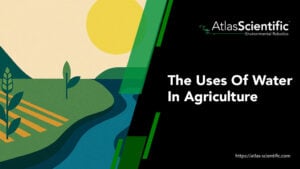

The Uses Of Water In Agriculture
Water monitoring is becoming crucial as agricultural droughts become more common and the global population rises, and solutions are needed to feed everyone with less
# Type at least 1 character to search # Hit enter to search or ESC to close

No products in the cart.

No products in the cart.
Product Categories

Water monitoring is becoming crucial as agricultural droughts become more common and the global population rises, and solutions are needed to feed everyone with less water. By learning precisely how water flows through agricultural systems from water system to field to crop to runoff, farmers can make decisions that maximize efficiency for every drop.
Water is, in fact, the most critical input in the modern agricultural puzzle. In a system where efficient water management practices can influence global food security, every drop counts.
Whether you are a commercial farmer, a small-scale organic producer, or an agricultural consultant there are ways that you can assess how water is being used within agricultural systems to better inform decisions about water management and monitoring.
In this article, we will look at the various roles of water within agriculture, outline the complexities of agricultural water management, and reveal how monitoring technology is driving efficiencies in water use throughout farms all around the globe.
We know that around 70% of all freshwater withdrawals worldwide are used for agriculture, which makes it the leading consumer of the planet’s finite water resources. With the continued growth of the global population—a figure we’re on track to see reach nearly 10 billion people by 2050, the pressure is only going to increase on agricultural water. This puts a lot of pressure on farmers to use water efficiently while maintaining or even increasing productivity.
The numbers are alarming – just 0.5% of Earth’s water is usable freshwater, and climate change is pushing the availability of that supply even lower. Nearly 2 billion people around the world are without safe drinking water, and roughly half of the global population has experienced severe water scarcity at some point. These challenges position water monitoring, conservation, and management as an integral pillar for sustainable agriculture.
In agriculture, irrigation is the largest scale usage of water and it accounts for the major part of water spent in agriculture sector. There are several types of modern irrigation systems, each offering different advantages and levels of water efficiency:

The selection of an irrigation system depends heavily on multiple factors ranging from the type of crop being grown, environmental factors such as soil types and climate conditions, water availability, energy costs, and available technology.
More recently, farmers have adopted precision irrigation systems that use real-time monitoring information to inform their irrigation decisions.
Water is an important component of all livestock production and performs many critical functions:
All livestock need access to fresh, clean drinking water on a daily basis. The amount required is very different per species, size, production phase and environmental conditions.

For example:
Barns, milking parlors, processing areas, and equipment are washed down to maintain sanitation and prevent disease, a process that relies heavily on the use of water.
Sprinklers and misters to cool livestock during high-heat days, also prevents heat stress especially on dairy and swine operations.
The production of feed crops and forage uses substantial water indirectly through livestock.
When water has been applied and air temperatures drop below 32°F (0°C), this water will freeze, forming a protective coat of ice, keeping the tissue temperature at 32°F (0°C), preventing injury from lower air temperatures. This is a common technique in fruit orchards and vineyards.

Under very high-temperature conditions, water is pumped through irrigation systems overhead, so that it evaporates as bean temperature decreases, preventing heat damage.
Water is applied to remove excess salts from the soil profile, especially in arid regions where salt buildup would impede plant growth.
Water acts as a carrier for agri chemicals and nutrients, enabling their controlled application as well as distribution within the area.
Freshly harvested produce is washed to eliminate soil, debris, and potential contaminants in advance of processing or marketing.
Water is used to quickly cool freshly harvested crops, especially leafy greens and other perishables, thereby prolonging shelf life and quality.
Water acts as a medium for collection and transportation of some crops like cranberries which are grown in flooded fields.
Food processing activities need large amounts of water for cleaning, cooking, blanching, and other preparation methods.
These soilless growing systems are among the most water-efficient types of agriculture available:
In hydroponic systems, plants grow with their roots submerged in water infused with nutrients or an inert medium such as coconut coir or rock wool that’s periodically drenched with nutrient solution.
Recirculating hydroponic systems use 90% less water than conventional field agriculture whilst producing more yields.
It is the combination of aquaculture (raising fish) with hydroponics in a symbiotic environment. Plant roots filter the water for the fish, and fish waste acts as nutrients for the plants.

These systems in a closed loop are also extremely efficient and use approximately only 10% of the water as compared to traditional farming methods.
Rice cultivation is unique in its water needs:
In classic rice production, fields are flooded to depths of 4–6 inches and then drained during most of the growing season, resulting in iconic rice paddies that dot the Asian landscape and many other rice-producing regions.

A more recent method that alternates between flooding and allowing the soil to partially dry can increase water use efficiency without compromising yields.
SRI is an integrated system involving water management techniques which enable up to 50% water saving compared to conventional paddy cultivation.
Specialty crops also have special water needs:
Besides that, water quality is equally as important as quantity for successful agriculture. Various agricultural applications have their requirements in terms of quality, and it is important to monitor these parameters:
Most of the agricultural water use has an optimal pH range of 6.0 to 8.5. Soils tend not to be able to carry water much outside this range before water impacts soil chemistry, nutrient availability, and the effectiveness of agricultural chemicals.

This is a measurement of the salinity or total dissolved solids in the water. Different crops have different levels of tolerance:
In aquaculture and hydroponic systems, DO (typically 5-14 mg/L) is especially important for the health of root systems and microorganisms.
Iron, manganese, zinc, and copper are trace elements needed for plant development, but can be toxic in higher concentrations:
The presence of pathogenic bacteria, blue-green algae and other microorganisms can have an impact on crop health and food safety.
Economically, modern agriculture increasingly adopts advanced monitoring technologies to maximize water usage. These systems offer real-time information about water quantity and quality, which enables precision management decisions:

Contain 2 probes which create an electric field. The sensors can be installed at several depths to cover the moisture profile throughout the root zone.
These probes measure soil water tension, the effort that plants have to make to pull water out of the soil.
They are the most professional types of soil moisture measuring instruments, using the principle of detecting hydrogen atoms in soil, they can provide the most accuracy in measurement considering the whole profile of soil.
This technique uses electromagnetic pulses to accurately measure soil moisture content.
Continuous monitoring of whether the water is acidic or basic maintains ideal conditions for nutrient availability and chemical effectiveness.
Measure salinity in irrigation water and soil solution to avoid salt build-up.
Important for aquaculture, hydroponics, and evaluation of biological activity in water bodies.
Track key nutrient levels such as nitrate-nitrogen and ammonium-nitrogen to optimize and avoid fertilizer runoff
They measure water temperature, which influences dissolved oxygen levels, chemical reactions, and biological activity.
Measure the quantity of water flowing through irrigation systems, assisting in tracking usage and identifying leaks.
Help you monitor pressure in irrigation lines to make sure the system is working correctly and is distributing water efficiently.
Providing data on rainfall, temperature, humidity, and evapotranspiration rates to enable decisions regarding irrigation scheduling.
Using satellite and drone imagery to identify crop water stress over extensive areas can help optimize irrigation.
Good agricultural water management combines monitoring data with strategic practices to achieve efficiency:
Many farmers are doing better with advanced irrigation management that applies water when and where it’s needed in real time:

Such field-level practices serve to optimize the use of available water:
But healthy soils naturally hold more water:

Water resources on the farms are just the first part; agricultural water management is an issue of protection of surrounding water bodies, too:

With the growing scarcity and value of water, a number of developing trends are paving the way for the future of agricultural water management:
Development and adoption of crops that produce well with less water.
Water Storage Infrastructure: Increasing on-farm capacity to capture precipitation during wet periods for use during dry periods.

Connected sensors provide comprehensive, accurate, real-time monitoring across entire watersheds and farming regions.
Cutting-edge monitoring technology offers valuable information about water amount and quality, allowing precision management that would have been unimaginable just a generation ago. By persistently tracking important parameters such as soil moisture, flow rates, conductivity, pH, and nutrients, the agricultural production industries can time precisely the right amount of water at exactly the right moment and identify and rectify quality issues prior to impacting crop yields.

Understanding these water uses in the agricultural sector is the basis for strategies that effectively manage water and balance productivity with sustainability. Whether you are a producer aiming to optimize water productivity, a conservationist aiming to guard natural resources, or a technology provider that creates new-generation solutions, understanding applications of water in agribusiness is the insight that drives impact.
If you would like to learn about the invaluable agriculture measuring tools we have to offer, do not hesitate to contact the world-class team at Atlas Scientific.

Water monitoring is becoming crucial as agricultural droughts become more common and the global population rises, and solutions are needed to feed everyone with less

The ways to reduce Total Dissolved Solids (TDS) in water are reverse osmosis (most common process, 90-99% removal of dissolved solids using a semi-permeable membrane),
Notifications